Semi-aquatic mammals like lemmings, rats, minks, water shrews, and otters are known to be excellent swimmers thanks to their nimble bodies.
You would think that bigger-sized animals will have a hard time navigating themselves in water, especially members of the bovine family, due to their weight.
So, can cows swim? Cows can swim. Turns out most land mammals, regardless of size, can learn how to swim as part of evolutionary adaptation. The principles of swimming and buoyancy also apply to cows’ sizes which means their large bodies help them be able to swim whenever they want to.
To find out more about how and why cows swim, whether they can swim underwater or in the sea, the benefits they get when swimming, how to create a safe environment for cows to swim, and more, this article will provide you with answers to everything you want to know.
Do Cows Float or Swim?
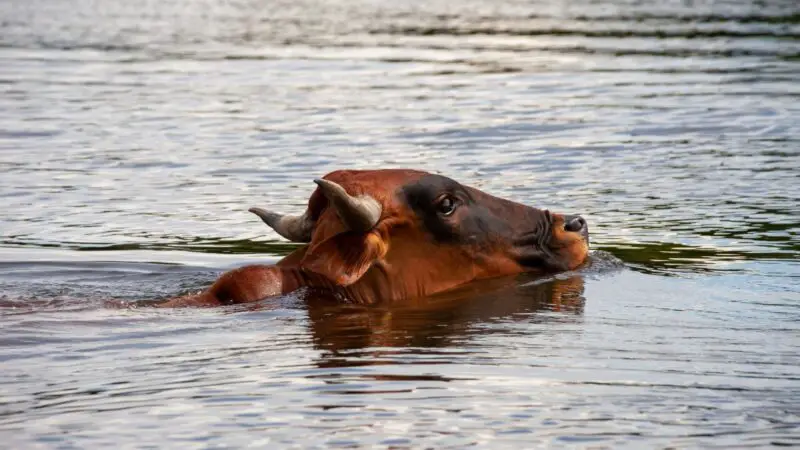
Cows can both float and swim because of their sturdy limbs. They know how to use their horns to angle and keep their heads above water. When they float, they tend to stay perfectly still.
Cows are known to stand on shallow streams and riverbanks because of the water’s coolness. They also swim deeper into the water to look for edible underwater plants.
How Do Cows Swim?
Their front limbs, which are responsible for mobility, exhibit a 45° degree range of motion that allows them to paddle in the water. The hind legs will then support the cows’ overall movements and keep them from sinking similar to how dogs manage to swim by doggy paddling.
Additionally, their big bodies give them enough buoyancy to stay afloat easily and for longer periods. They have fatty tissues embedded within and outside of their muscles, which adds to their floating abilities.
Cows are great swimmers because they travel across rivers, streams, and ponds to search for abundant forage and pastures on the other side of the land.
How Far Can a Cow Swim?
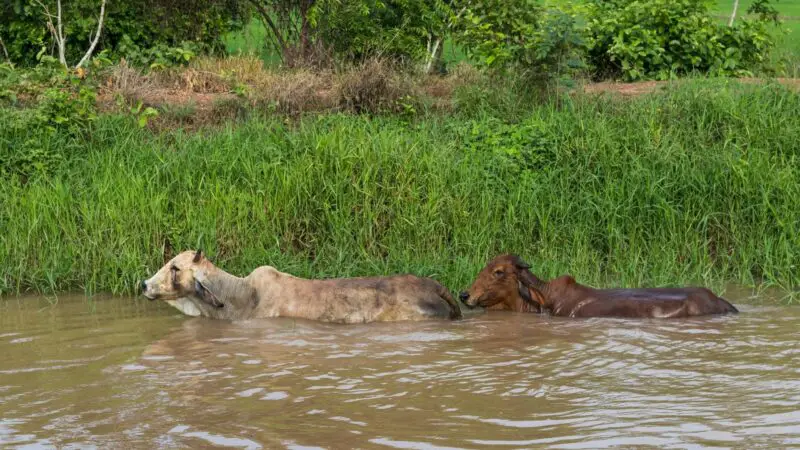
Cows can swim up to a hundred yards of their own accord. But when they end up accidentally swimming, they can stay afloat for more than 2 miles, assuming they return safely to land.
There is evidence of 24 crows from Crom in Fermanagh swimming 109.3 yards (100 m) across Lough Erne, a lake system found in Northern Ireland, in search of fresh pastures to graze. In fact, it was an annual event for these cows.
3 cows have been spotted on a beach in North Carolina after being swept by Hurricane Dorian 2 miles (3.22 km) away from their hometown, Cedar Island. An official spokesperson believes the cows swam for 4 miles (6.4 km).
A cow was also found floating in River Ouse in Yorkshire, England after allegedly swimming 4 (6.4 km) to 5 miles (8 km).
Do Cows Like Water and Swimming?
Like any other mammal with the ability to swim, cows will initially be afraid of the water and may even develop phobias. However, once they get used to it, they may become adept swimmers.
During intense summer heat and drought, water is highly important for the survival of cows. It also helps maximize milk production that is otherwise delayed or slumped by the heat.
It is recommended for farms and ranches to install sprinkler systems or water tanks to provide regular water access for cows, according to an energy engineer.
Can Cows Swim Underwater?
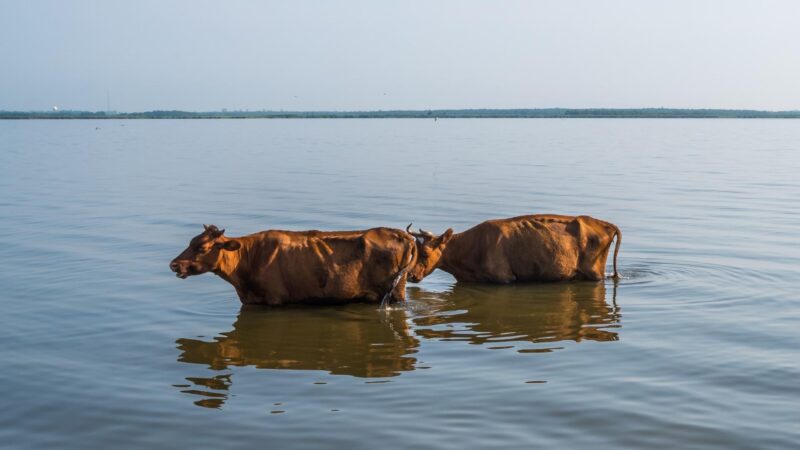
Cows cannot swim underwater. They cannot breathe underwater nor hold their breaths long enough.
However, they can swim and stay afloat in deep waters. They also like to graze on underwater plants now and then if they can find them.
How Fast Can a Cow Swim?
There are no scientific or farm records showing how fast cows swim. This all boils down to their time to exhaustion (they take breaks after standing up for 3 hours, so they tire easily), water conditions, body drag, level of buoyancy, and hydrostatic pressure—all of which haven’t been put to the test for proper measurements yet.
Can a Cow Swim in the Sea?

Cows can swim in the sea, but they’ll most likely drown the more they swim since seas have unpredictable currents and waves of varying lengths.
A spokesperson from the Cape Lookout National Seashore during Hurricane Dorian claims that if the cows that were swept away vented out into the Atlantic Ocean, they would have drowned.
Can Baby Cows Swim?
Baby cows can also swim, but at shorter distances and in shallower waters. Like humans, they may follow the example of their mothers.
How to Help the Cows Swim Safely?
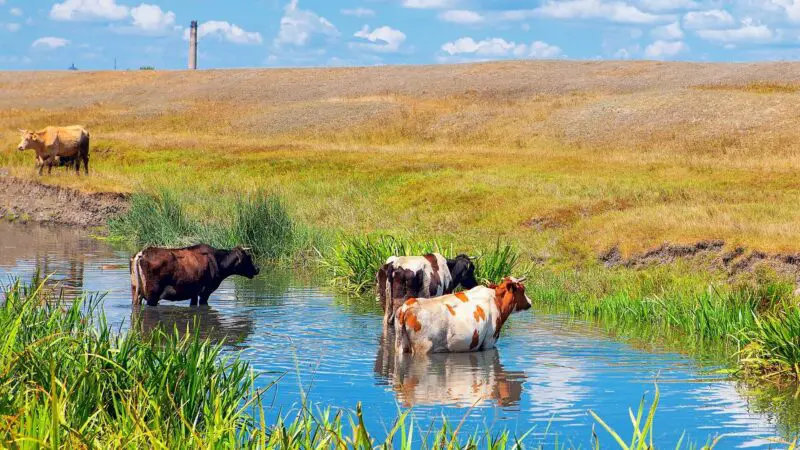
Seasoned farmers, ranchers, and cowboys would want to safely transfer their cows across rivers, streams, ponds, and lakes and ensure that they will stay afloat throughout their time swimming.
Here are steps on how to help cows swim safely:
1. Take the Initiative
Educating cows is the same way you educate humans: you must make an example first. You can teach the lead steer first, and the rest will follow in their footsteps. Bring the steer into the water with a bit of peer pressure. Then, check how the other cows of the herd react.
2. Group the Herd
For those who don’t follow the lead cow or are just too scared to dip themselves in the water, separate them from the group. Ranchers should then hold them together and force one or two cows into the water. This way, they won’t bother retreating since they’d be submerged already.
With this, the other hesitant cows will follow. It helps if the cows are thirsty beforehand or have dry skins.
3. Remain Downstream
Ranchers should stay with the cows on the downstream side. They should use the leading cows as bait for all the other remaining cows on the opposite side. This will be your last resort, but it works like a charm.
Benefits of Swimming for Cows
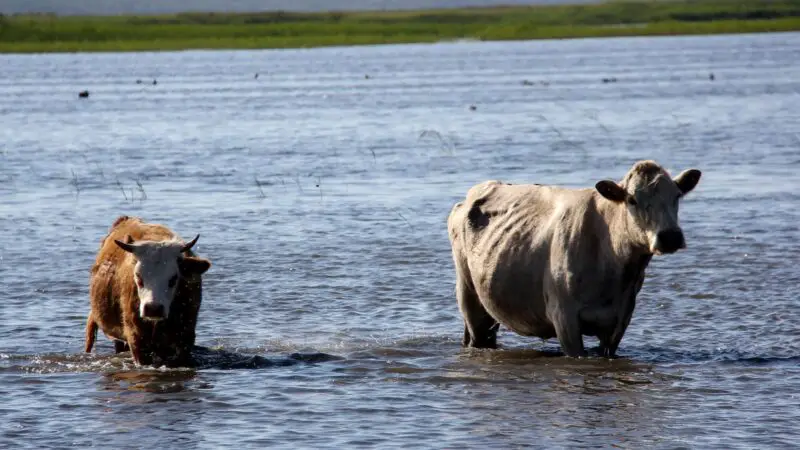
Swimming helps cows cope with the heat during summer and droughts. It enables them to travel across pastures and fields to look for more supplies of food.
Once they exhaust the forage they’ve found, they go back to the mainland or their original farms. Swimming also helps them escape potential predators.
Frequently Asked Questions
What Other Land Mammals Are Good Swimmers?
Dogs are great swimmers and love to do so for recreation or for battling the intense heat during summer seasons at speeds of 2 miles (3.2 km) to 2.5 miles (4 km) per hour.
Elephants are known to be good swimmers. They are capable of reaching up to 20 miles (32.1 km) in a day and swimming as fast as 1.7 miles (2.7 km).
Despite their notoriously slow movements, sloths are also great swimmers. They move faster in water than they do on land.
Pigs can also swim, and there are even photographic records of pig swimming competitions dating back to 1946 in Kirkland, Washington.
Tapirs, one of the largest indigenous land mammals, are excellent swimmers and are natural in them. They start swimming as early as 3 weeks old, often with their mothers. Their unique feet composed of 4 toes on the front and 3 toes on the back helps them swim.
Can a Bull Swim?
Bull can swim. It is important to note that bulls are used to refer to mature male cattle, while cows refer to mature female cattle. Since cows can swim, bulls definitely can too.
Can Dairy Cows Swim?
Dairy cows can swim. Cows, in general, can swim regardless of their herding or livestock farming purposes.
Summary
Cows, and bulls, can swim up to 2 or more miles (3.2 km) but are limited only to streams, lakes, rivers, and ponds as they’ll drown in seas and oceans if they attempt to swim due to strong currents and waves.
They possess enough buoyancy to keep afloat and have sturdy limbs capable of paddling themselves. They swim to look for forage and sometimes escape predators in their vicinity.
List of Sources
Three Cows Swept Away by Hurricane Dorian Have Been Found Alive
